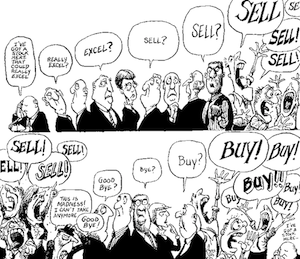The following guest post is by Mark Meldon – our favourite independent financial advisor (in an admittedly narrow field!) Now and then we persuade Mark to explain some of the more obscure or technical corners of personal finance.
I believe it’s worth us returning to the topic of life assurance – one of the essential matters that Monevator readers need to consider on a regular basis.
There seems to be some mass incoherence amongst the general population when it comes to confronting our mortality.
People – willfully or otherwise – forget that we all dangle by a very thin thread.
The result is that taking out insurance to protect dependants by creating a tax-free pool of money to replace lost income is an option simply ignored by millions of us.
Many independent financial advisors (IFAs) don’t bother with insurance either, as they say it isn’t profitable.
That’s crazy – and irresponsible – in my view.
All of your sexy investment and pension plans can soon turn to dust should disaster strike. For the sake of paying very modest premiums – for something I sincerely hope you never need to use – you can cover off that risk.
You hope they don’t pay
On a more positive note, there is plenty of money going out to beneficiaries who’d surely back up what I’m saying.
In 2017, Aviva paid out £525m in death claims, Legal & General £636m, Royal London £517m and Zurich Assurance £235m. AEGON recently stated it paid out £67m in 2018.
These companies are some of the largest providers of life cover in the UK, but others are available in what is a fiercely competitive market.
It’s also interesting to note that policies arranged through an intermediary such as an IFA tend to have a much larger sums assured. I’d hope this is because careful thought has gone into the amount required by a given individual, as opposed to a scattergun approach.
I am, however, concerned that something like 85% of life insurance policies arranged each year are not set up properly at outset. This can cause severe difficulties in many circumstances.
It is all to do with ‘writing’ the policy into a trust. The recent deferral by the government of proposed big increases in probate fees set me thinking more about this.
The suggestion of an increased liability for IFAs like me for failing to take reasonable steps to ensure that life policies are protected from probate is of serious concern to me, my family – and my professional indemnity insurers.
Let’s hope that the ambulance chasers don’t get involved.
Unmarried couples beware!
Mind you, with average life policy sums insured still far below £200,000, inheritance tax is unlikely to be a big problem for most people.
But something else really could be.
Let us say that you took out a life policy with a sum assured of £250,000 because you have just become a parent. Imagine your partner did exactly the same.
Sensible. You bought the policy with every good intention, either online or, perhaps, through an IFA. You’ve been paying your premiums ever since.
Job done!
Or is it?
Like many couples nowadays let’s say you’re not married but rather cohabit a house with your growing family. Sadly, you then die.
How would you feel if, on your deathbed, you realised that your soon-to-be-bereaved partner for whom the life cover was intended stood to get nothing at all – a 100% loss, of typically around £150,000?
This doesn’t happen because your policy provider declined the claim. Rather it happens because your policy wasn’t set up properly.
Well I’m afraid that this is what can easily happen to unmarried couples, because the sum insured would fall back into your estate and be subject to your will or the laws of intestacy.
It could then end up in the hands of the wrong people who might – just might – refuse to hand the money over to the person you intended it for.
Yikes!
Use a trust
Until a few years ago this was a very small problem. Most life policies arranged by new parents – or those with joint liabilities such as mortgage payments or the rent – were joint life policies.
These joint life policies paid out to the survivor after the first death.
Besides, even if a single life policy had been arranged most couples back then would have been married and the laws of intestacy – or their will, assuming that had one – would have likely saved the day.
So much for yesterday – what about today?
Anecdotally, something like 70% of life policies arranged nowadays are arranged on a single life basis. There may be good reasons for this. But it presents a big problem for the growing number of unmarried couples who just don’t understand how important it is to set their policies up correctly.
The solution is to write the policy into a trust AND make sure that there is at least one trustee – hopefully the partner for whom you bought the policy in the first place.
Prepare properly for the unthinkable
The proportion of couples that are unmarried continues to increase. The highest share is among the age groups who already have small children, and who are first-time buyers or renters.
According to the Office for National Statistics, nearly 40% of unmarried couples have a male partner aged 30-34. Some 70% of children are born with a father aged between 25-39.
Yet research from Unbiased found in 2017 that 72% of 35-54-year olds don’t have a will!
Even if you have a will – and you really must – don’t forget that it can be challenged. And it still has to go through probate and, perhaps, inheritance tax calculations.
According to the recent British Social Attitudes Survey, approximately 50% of couples wrongly believe that there is such a thing as a common law marriage. There is no such thing!
Hence, I find it almost unbelievable that only around 7% of life policies are set up wrapped in a trust when, in truth, nearly all should be.
Case study: Second time around
It is quite common, nowadays, for relationships to be very different from our grandparents’ time because of marriage or cohabiting breakdowns, and these often involve children.
Indeed I have just been dealing with a situation where simple life insurance has been employed to solve a tricky problem as a new relationship beds down.
It is all about ‘financial input’ – cold-blooded as that phrase is – and unforeseen consequences.
One of my clients, let’s call him John, is a lovely chap. Sadly, John’s first wife died ten years ago at a young age, leaving him with two small children to raise on his own. His late wife carried substantial life insurance, and there were generous pension benefits, too. John has raised a fine pair of young adults who, I’m sure, will go on to lead successful lives.
Time is a great healer. John is now closely involved with Jane and, I’m pleased to say they intend to marry next year.
Jane is divorced and has two younger children from her previous relationship. Because of their ages, there won’t be any new children. They each own houses – Jane’s with a mortgage – and they would now like to purchase a property together and set up a new family home.
Very fortunately, they are looking at properties around the £1m mark, as the life insurance that paid out 10 years ago has been invested and produced good returns.
Of this £1m budget, the input from John will be about £800,000, and from Jane £200,000. Quite understandably, they both wish to ensure that their own children receive their ‘due’ when they die, so they are arranging with their excellent solicitor to purchase the new property as tenants in common, with John initially owning 80% of the new home, and Jane 20%.
So far, so good.
However if one or the other of this couple should have the bad timing to die sooner rather than later, it creates a problem for the survivor as far as paying the kids’ inheritances are concerned.
Jane has not got £800,000 available to buy out John’s children’s financial ‘expectations’ and, although John would be able to dip into his funds to cover those of Jane’s children, he would prefer to avoid having to do so, as the money should pass to his own children.
I therefore suggested that John purchase £800,000 of life cover to age 70 (by which time they might be thinking of downsizing and so on) and Jane £200,000 on a similar basis.
These policies have been set up with John’s children as the ‘named beneficiaries’ on his policy and Jane’s children on hers. The insurance will be in a ‘flexible trust’ from the outset, with each other being appointed as trustees. We have also appointed another independent trustee who can act as ‘overseer’ should a claim unfortunately arise.
If John dies whilst the policy is in force, the £800,000 would be paid out, tax-free, to his trustees (Jane and the referee trustee), thus giving Jane the funds to ‘buy-out’ John’s children’s interests in the property. This would allow Jane the luxury of not having to sell the home to raise the funds to do so.
My couple felt that the monthly premiums of under £150 were a price worth paying for peace of mind, covering off something that they were both concerned about.
Avoiding problems with trusts
Not writing a life insurance policy in trust is pretty daft, I have to say, and that goes for new and existing policies.
I hope I have explained why, for the sake of a bit of thought, you really need to do this.
Happily, this problem is simple to avoid or deal with. Several of the insurers I mentioned earlier have put great effort into getting it done right at outset, with superb online trust documents. Even the ones still using paper-based documents have excellent trust wordings available free of charge.
My suggestion? Check your policies, set up a trust for your loved ones, and write a will. And if any of this seems difficult, ask an experienced and qualified IFA for help.
Mark Meldon is an Independent Financial Advisor based in Cheddar, Somerset. If you need an IFA closer to home, try the directory at Unbiased. You can also read Mark’s other articles on Monevator.











